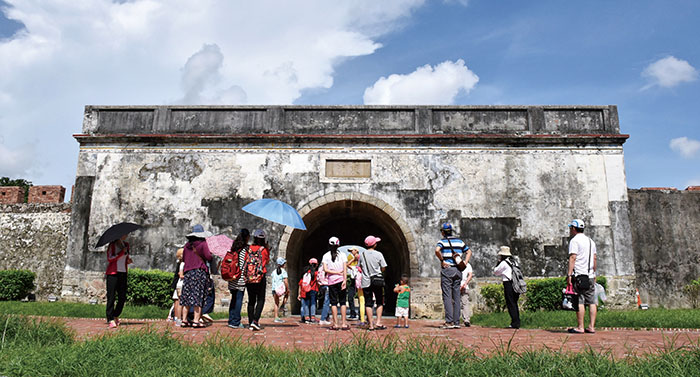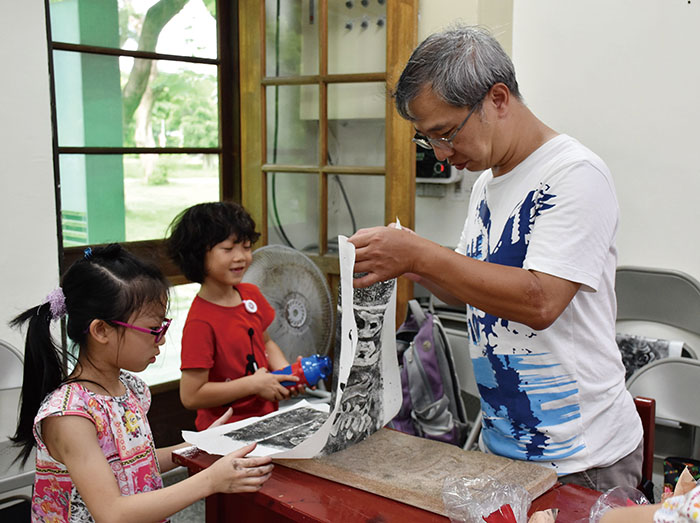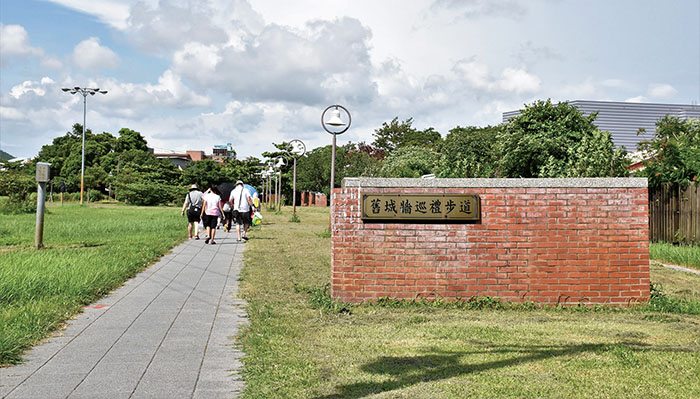Touring Historical Zuoying's Old Fongshan City
Touring Historical Zuoying's Old Fongshan City
◎English translation: Hou Ya-ting
◎Photos by Li Jian-shan
Kaohsiung's Zuoying District is considered a culturally significant part of the city and beholds many historical sites. Some of these heritage sites are currently being restored by Kaohsiung City's Bureau of Cultural Affairs. Kaohsiung City Government is making endeavors to promote Zuoying District's heritage sites to more people, with the hopes of cultivating a greater appreciation for local culture and history. The bureau sought out Kaohsiung's Old Fongshan City Culture Association to partner with them in developing tours of the refurbished projects. Since 1999, Kaohsiung's Old Fongshan City Culture Association has been preserving historical sites in Zuoying District.
 In order for the public to get an up close and personal view of the refurbished sites, the organization provides professional guides to lead half-day trips around Old Fongshan. However, tours will only be available until November. They take visitors on a trip through time to various sites that date back as far as the Ming Dynasty. The sites include most of Taiwan's significant historical periods including relics from the Kingdom of Tung Ning which was ruled by the Jhang Family, to the Manchu Cing Empire, to Japanese colonial rule and finally the ROC on Taiwan.
In order for the public to get an up close and personal view of the refurbished sites, the organization provides professional guides to lead half-day trips around Old Fongshan. However, tours will only be available until November. They take visitors on a trip through time to various sites that date back as far as the Ming Dynasty. The sites include most of Taiwan's significant historical periods including relics from the Kingdom of Tung Ning which was ruled by the Jhang Family, to the Manchu Cing Empire, to Japanese colonial rule and finally the ROC on Taiwan.
Some may consider a historical trip to be rather uninteresting. However, Kaohsiung's Old Fongshan City Culture Association has facilitated animated guides and the tour has been well received among participants of all ages. Kaohsiung's Old Fongshan City Culture Association can also tailor tours for people of all ages. On June 24, eight families of young people and their parents were given a tour by one of the association's most senior guides, Mr. Chen Jhen-rong.
The first stop was Old Fongshan City's East Gate. Along the way, Mr. Chen Jhen-rong interacted with the young group  members and tested their historical knowledge by asking them a variety of questions. One of these questions included, "Where did the name Kaohsiung come from?" The young participants answered promptly, indicating they already had some foundation in local history.
members and tested their historical knowledge by asking them a variety of questions. One of these questions included, "Where did the name Kaohsiung come from?" The young participants answered promptly, indicating they already had some foundation in local history.
Kaohsiung had been previously known as Ta-kao (meaning bamboo forest) by the Makadao Tribe, a branch of the Pingpu aborigines. During Japanese colonial rule, it was pronounced Takau, in Japanese, but in Kanji it was written 高雄 and pronounced Kaohsiung, in Mandarin. Mr. Chen Jhen-rong then explained that Zuoying had also once been a Ming-dynasty historical site and where Jhang Cheng-gong's troops had set up their military base. When the group reached the East Gate, Mr. Chen pointed out that the slope in front of the East Gate resembled a soaring phoenix and it was from this that the area got its name Fongshan (Phoenix in Mandarin).
Mr. Chen Jhen-rong pointed out that during the Jhang Family rule (1661-1683), Zuoying was considered to be a very strategic location. But the region's defense walls weren't built until the Manchu Cing-dynasty took control and Taiwan (Tung Ning as it was known at the time) fell under Emperor Kangsi's rule. The Manchu Emperor had fully understood how strategic Zuoying was and didn't want it to be vulnerable or to fall into rival empires' hands.
He explained that during Japanese colonial rule, Zuoying was transformed into a restricted military area. As a result, residences and temples were relocated out of the area. Later, when the ROC government took over Taiwan, three naval villages were established there. The naval villages had now been relocated, but some of the naval villages have been preserved as historical sites. Later the government administration was relocated from Zuoying to Fongshan and the residents previously from Zuoying called it, "The old town" and Fongshan, "The New Town".

After the walking tour of the historical sites, Mr. Chen then took the tour back to the association's office, to learn the process of stone tablet printing. This hands-on activity would demonstrate how printing was carried out back in the Manchu Cing Dynasty. This type of printing has often been found at local archaeological sites, and Mr. Huang hoped the young participants would get an understanding of how invaluable stone tablets were. He explains how they have been preserved and studied in academic research. The association provided mini stone tablets, which bore the inscription that appears above the Fongyi East Gate. Mr. Huang was the activity leader and taught the young people how to emulate the process. Step by step, he showed them how to attach the rice paper to the model tablet, glue the rice paper on and then rub it smooth with a bristled brush. He then applied ink, which permeated through the rice paper, creating a readable inscription. It was really exciting for the young participants to create their own copy of the historical wall's inscription.
At the end of the demonstration, Mr. Chen Jhen-rong expressed how much he had appreciated the young people's enthusiasm. They too had enjoyed the walk around the historical sites and learning about the local culture. They had also enjoyed answering Mr. Chen's questions and doing the stone tablet printing activity.
The association offers two historical routes around Zuoying's Old Fongshan City Wall. The first is the North-East Route which takes people around Old Fongshan East Gate. They will then see the city's moat, the former Guangong Taoist Temple, forts that were built during Japanese colonial rule, the former Sinlong Temple, Old Fongshan City's North Gate and Dragon Tiger Tower.
The second is the South-West Route which includes the three-hundred years old Sinlong Well, Old Fongshan's South Gate, the old army sentry located on Zuoying Ave. and Bisheng Road, Old Fongshan's West Gate, a Japanese shrine, Triangle Park, the Cing-dynasty Administration Office and Waisinlong archaeological site.